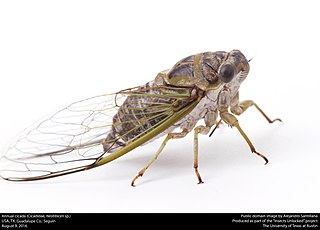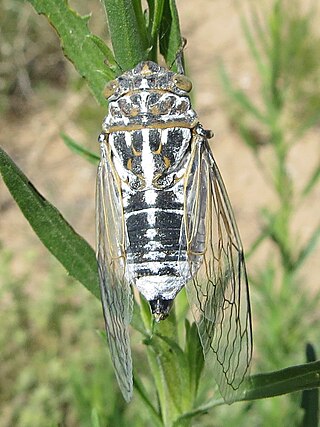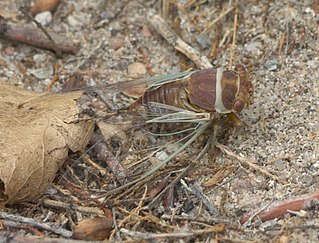Related Research Articles

Cicadidae, the true cicadas, is one of two families of cicadas, containing almost all living cicada species with more than 3,200 species worldwide.

Cicadas of the genus Neotibicen are large-bodied insects of the family Cicadidae that appear in summer or early fall in eastern North America and formerly Bermuda. Common names include cicada, harvestfly, jar fly, and the misnomer locust.
Katoa is a genus of cicadas from Southeast Asia. The type species is Katoa tenmokuensis. Formerly placed in the tribe Tibicinini, after detailed morphological analysis, in 2012 Lee placed the genus among the Cicadettini, also of the subfamily Cicadettinae. After molecular phylogenetic analysis and physical examination, in 2018 Marshal, et al., placed the genus in its own tribe, Katoini, remaining in the subfamily Cicadettinae.

The Cicadinae are a subfamily of cicadas, containing the translucent cicadas. They are robust cicadas and many have gaudy colors, but they generally lack the butterfly-like opaque wing markings found in many species of the related Tibiceninae.
Tibiceninae is a former subfamily name from the insect family Cicadidae. It was first used by Distant (1889). As of 2021, the name became unavailable to zoological nomenclature due to the suppression of its type genus Tibicen Berthold, 1827 by the International Commission on Zoological Nomenclature. Cicada genera grouped at the subfamily level with genus Lyristes are generally referenced under the name Cicadinae Latreille, 1802.

Cryptotympanini is a tribe of cicadas in the family Cicadidae. They are found in the Nearctic, Palearctic, Indomalaya, Oceania, and Afrotropics.

Neotibicen tibicen, known generally as the swamp cicada or morning cicada, is a species of cicada in the family Cicadidae. It is widespread across much of the eastern and central United States and portions of southeastern Canada. There are two subspecies, N. tibicen tibicen and N. tibicen australis, with the latter replacing subspecies tibicen in portions of Florida, Georgia, and Alabama.

Tibicen is a former genus name in the insect family Cicadidae that was originally published by P. A. Latreille in 1825 and formally made available in a translation by A. A. Berthold in 1827. The name was placed on the Official Index of Rejected and Invalid Generic Names in Zoology by the International Commission on Zoological Nomenclature in 2021. Certain European cicada species that were included by some authors in this genus at the time of its suppression are now listed under genus Lyristes Horváth, 1926. Other formerly-Tibicen species are placed in the tribe Cryptotympanini and include the genera Auritibicen Lee, 2015, Hadoa Moulds, 2015 Megatibicen Sanborn and Heath, 2016, and Neotibicen Hill and Moulds, 2015.

The genus Hadoa comprises large-bodied Cicadidae occurring in Western North America. Until recently, these species were in the genus Tibicen, which has now been redefined so as to include only a few European species, while most species from the Eastern and Central US are now placed in Neotibicen and Megatibicen.

Megatibicen is a genus of cicadas in the family Cicadidae, with about 10 described species. Until 2016, these species were included in the genus Tibicen and then briefly in Neotibicen. The species formerly of genera Ameritibicen Lee, 2016 and Gigatibicen Lee, 2016 are now considered species of Megatibicen Sanborn & Heath, 2016.

Diceroprocta is a genus of scrub cicadas in the family Cicadidae. There are at least 60 described species in Diceroprocta.

Cicadettini is a tribe of cicadas in the family Cicadidae. There are at least 110 genera and 520 described species in Cicadettini, found worldwide except for the Neotropics.
Hemidictyini is a tribe of cicadas in the family Cicadidae, found in the Neotropics and tropical Africa. There are at least two genera and two described species in Hemidictyini.
Parnisini is a tribe of cicadas in the family Cicadidae. There are more than 20 genera and 80 described species in Parnisini, found in the Neotropics, Palearctic, tropical Africa and Madagascar.
Prasiini is a tribe of cicadas in the family Cicadidae. There are about 9 genera and at least 50 described species in Prasiini, found in tropical Africa, Australasia, and the Neotropics.
Taphurini is a tribe of cicadas in the family Cicadidae, found in the neotropics.
Nelcyndana is a genus of cicadas in the family Cicadidae, found in southeast Asia and the Philippines. There are about five described species in Nelcyndana.
Burbunga is a genus of cicadas in the family Cicadidae, found in Australia. There are about 11 described species in Burbunga.
Psithyristriini is a tribe of cicadas in the family Cicadidae, found in the Philippines. There are about 7 genera and at least 100 described species in Psithyristriini.

Lyristes is a genus of cicadas from Europe and the Middle East. It was described by G. Horvath in 1926.
References
- ↑ Distant, W. L. (1889). A monograph of Oriental Cicadidae. Calcutta: Indian Museum. pp. Parts 1 and 2: 1–48, pls i–iv.
- ↑ "Opinion 2475 (Case 239) – Tibicina Kolenati, 1857 and Lyristes Horvath, 1926 (Insecta, Hemiptera): usage conserved by the suppression of Tibicen Berthold, 1827; Cicada Linnaeus, 1758 (Insecta, Hemiptera): usage conserved by designation of Cicada orni Linnaeus, 1758 as the type species". The Bulletin of Zoological Nomenclature. 78 (2): 138–141. August 2021. doi:10.21805/bzn.v78.a032.
- ↑ Marshall, David C.; Moulds, Max; Hill, Kathy B. R.; Price, Benjamin W.; Wade, Elizabeth J.; Owen, Christopher L.; Goemans, Geert; Marathe, Kiran; Sarkar, Vivek; Cooley, John R.; Sanborn, Allen F.; Kunte, Krushnamegh; Villet, Martin H.; Simon, Chris (28 May 2018). "A molecular phylogeny of the cicadas (Hemiptera: Cicadidae) with a review of tribe and subfamily classification". Zootaxa. 4424 (1): 1–64. doi:10.11646/zootaxa.4424.1.1. PMID 30313477.